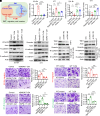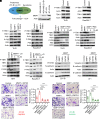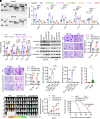Macrophage TBK1 signaling drives the development and outgrowth of breast cancer brain metastasis
- PMID: 40833415
- PMCID: PMC12403136
- DOI: 10.1073/pnas.2420793122
Macrophage TBK1 signaling drives the development and outgrowth of breast cancer brain metastasis
Abstract
Tumor-associated macrophages (TAMs) are the predominant immune cells in the tumor microenvironment that promote breast cancer brain metastasis (BCBM). Here, we identify TANK-binding kinase (TBK1) as a critical signaling molecule enriched and activated in TAMs of BCBM tumors, playing an indispensable role in BCBM development and metastatic outgrowth in the brain. Mechanistically, BCBM cell-secreted matrix metalloproteinase 1 binds to protease-activated receptor 1 and integrin αVβ5 on macrophages, leading to TBK1 activation mediated by the nuclear factor-kappa B pathway. Reciprocally, TBK1-regulated TAMs produce granulocyte-macrophage colony-stimulating factor (GM-CSF) to drive breast cancer cell epithelial-mesenchymal transition, migration, and invasion, ultimately contributing to BCBM development and brain metastatic outgrowth. Inhibition of TBK1 signaling in TAMs or GM-CSF receptor in cancer cells impedes BCBM development and brain metastatic outgrowth. Correspondingly, the TBK1-GM-CSF signaling axis correlates with lower overall survival in patients with BCBM. Thus, TBK1-mediated tumor-TAM symbiotic interaction provides a promising therapeutic target for patients with BCBM.
Keywords: GM-CSF; TBK1; brain metastasis; breast cancer; macrophages.
Conflict of interest statement
Competing interests statement:The authors declare no competing interest.
Figures






References
-
- Niikura N., et al. , Treatment outcomes and prognostic factors for patients with brain metastases from breast cancer of each subtype: A multicenter retrospective analysis. Breast Cancer Res. Treat. 147, 103–112 (2014). - PubMed
MeSH terms
Substances
Grants and funding
LinkOut - more resources
Full Text Sources
Medical
Miscellaneous

